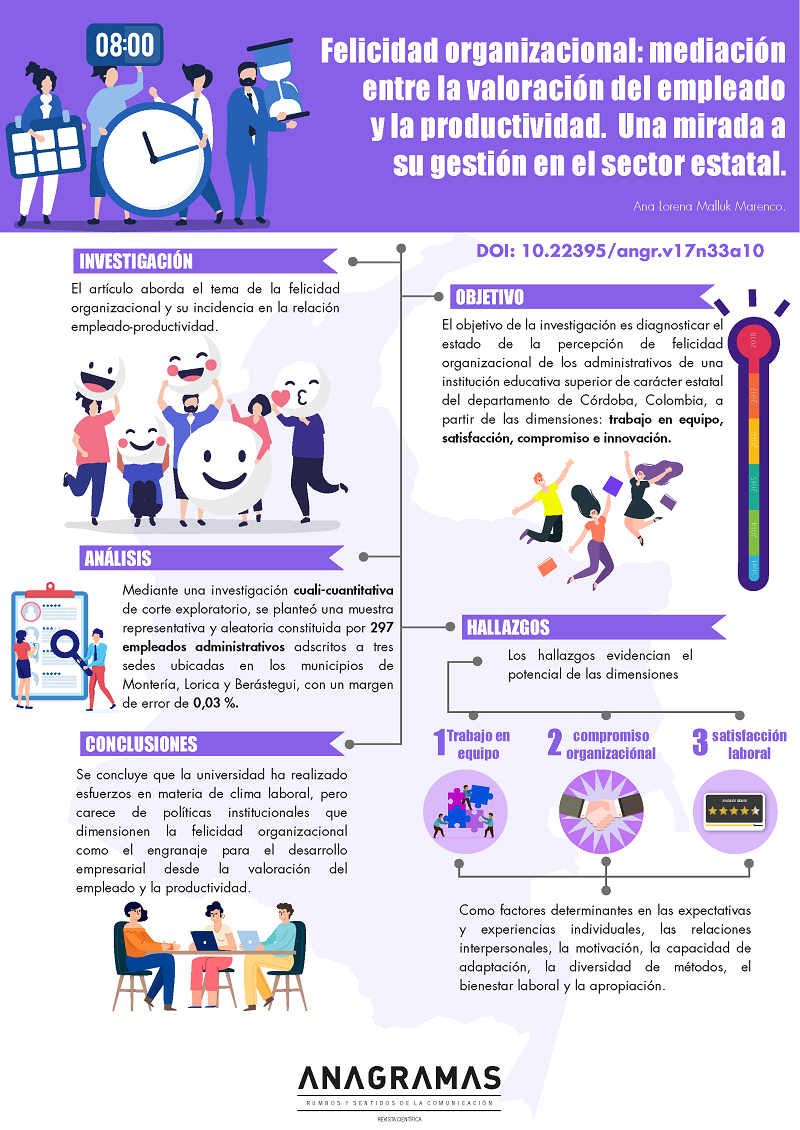Felicidad organizacional: mediación entre la valoración del empleado y la productividad. Una mirada a su gestión en el sector estatal
Contenido principal del artículo
Resumen
El artículo aborda el tema de la felicidad organizacional y su incidencia en la relación empleado-productividad. El objetivo de la investigación es diagnosticar el estado de la percepción de felicidad organizacional de los administrativos de una institución educativa superior de carácter estatal del departamento de Córdoba, Colombia, a partir de las dimensiones: trabajo en equipo, satisfacción, compromiso e innovación. Mediante una investigación cuali-cuantitativa de corte exploratorio, se planteó una muestra representativa y aleatoria constituida por 297 empleados administrativos adscritos a tres sedes ubicadas en los municipios de Montería, Lorica y Berástegui, con un margen de error de 0,03 %.
Los hallazgos evidencian el potencial de las dimensiones trabajo en equipo y compromiso con la organización/función y la necesidad de fortalecer la satisfacción laboral e innovación como factores determinantes en las expectativas y experiencias individuales, las relaciones interpersonales, la motivación, la capacidad de adaptación, la diversidad de métodos, el bienestar laboral y la apropiación.
Se concluye que la universidad –caracterizada por ser tradicional e influyente en el medio, con una estructura compleja, con un número de empleados superior a seiscientas personas y sujeta a vigilancia por parte del Estado– ha realizado esfuerzos en materia de clima laboral, pero carece de políticas institucionales que dimensionen la felicidad organizacional como el engranaje para el desarrollo empresarial desde la valoración del empleado y la productividad.
Detalles del artículo
Citas
Baker, W. y Sinkula, J. (1999). Learning orientation, market orientation, and innovation: integrating and extending models of organizational performance (Vol. 27). Boston: Journal of the Academy of Marketing Science.
Betancourt, A. (1985). Organizaciones y administración: un enfoque de sistemas. Cali: Norma.
Carballeira, M. González, J. Marrero, R. (2015). Diferencias transculturales en bienestar subjetivo: México y España. Anales de Psicología, 31(1), 199-206. https://doi.org/10.6018/analesps.31.1.166931
Cardona, C. (2002). Fundamentos de administración. Bogotá: ECOE.
Dankhe, G. (1986). Investigación y comunicación. En C. Fernández-Collado y G.L. Dankhe (Eds.), La comunicación humana: ciencia social (pp. 385-454). Ciudad de México: Mc.Graw-Hill.
Drucker, P. (1993). La sociedad poscapitalista. Buenos Aires: Sudamericana.
Dutschke, G. (2013). Factores condicionantes de felicidad organizacional. Estudio exploratorio de la realidad en Portugal. Revista de Estudios Empresariales, (1), 21–43.
Fernández, I. (2015). Felicidad organizacional: cómo construir felicidad en el trabajo. Santiago de Chile: Ediciones B.
Fisher, C. (2010). Happiness at Work. International Journal of Management Reviews, 12(4), 384-412.
Gutiérrez, M. y Gonçalves, T. (2013). Activos para el desarrollo, ajuste escolar y bienestar subjetivo de los adolescentes. International Journal of Psychology and Psychological Therapy, 13(3), 339-355.
Hernández Sampieri, R., Fernández, C. y Baptista, P. (2006). Metodología de la Investigación (4ª ed.). México: McGraw-Hill.
Hosie, P., Cooper, C. y Sevastos, P. (2007). The Happy Productive Worker Thesis and Australian Managers. Journal of Human Values 13(2), 151-176.
Malluk, A. y Bedoya, S. (2016). Diagnóstico de comunicación organizacional de la institución educativa Cristobal Colón de Montería,(tesis de pregrado) Universidad Pontificia Bolivariana, Monteria, Colombia.
Nader, M. Castro, A. (2010). Teorías implícitas del liderazgo, LMX y bienestar laboral: generalización de un modelo teórico. Revista de Psicología, 28(2), 227-258.
Meyer, J. y Allen, N. (1984). Testing the side-bet theory of organization commitment: Some methodological considerations. Journal of Applied Psychology, 69(3), 372-378.
Gamboa, E. (2006). Satisfacción laboral: descripción teórica de sus determinantes. Recuperado de http://www.psicologiacientifica.com/satisfaccion-laboral-determinantes
Oberle, E., Schonert-Reichl, K. y Zumbo, B. (2011). Life satisfaction in early adolescence: Personal, neighborhood, school, family, and peer influences. Journal of Youth and Adolescence, 40(7), 889-901.
Corral, S. y Pereña, J. (2003). Cuestionario de Clima Laboral (CLA): test para evaluar el clima laboral de las empresas y las organizaciones. Madrid: TEA.
Pulido, F. y Herrera, F. (2018). Predictores de la felicidad y la inteligencia emocional en la educación secundaria. Revista Colombiana de Psicología, 27(1), 71-84. https://doi.org/10.15446/rcp.v27n1.62705
Quiceno, J. y Vinaccia, S. (2015). Calidad de vida, fortalezas personales, depresión y estrés en adolescentes según sexo y estrato. International Journal of Psychology and Psychological Therapy, 14(2), 155-170.
Revista Líderes. (2014). Las empresas miran en la felicidad un nuevo indicador. Recuperado de https://www.revistalideres.ec/lideres/empresas-miran-felicidad-nuevo-indicador.html
Rodríguez, M. (2010). Métodos de investigación: diseño de proyectos y desarrollo de tesis en ciencias administrativas, organizacionales y sociales. México: Universidad AutoÌnoma de Sinaloa.
Caycho Rodríguez, C. (2010). Variables psicológicas asociadas con la felicidad en centros periurbanos y urbanos marginales de Lima. UCV-Scientia, 2(1), 61-68
Rodríguez, C. y Caño, A. (2012). Autoestima en la adolescencia: análisis y estrategias de intervención. International Journal of Psychology and Psychological Therapy, 12(3), 389-403.
Salanova, M., Martínez, I. y Llorens, S. (2005). Psicología organizacional positiva. en F. Palací (Coord.), Psicología de la organización (pp. 349-376). Madrid: Prentice-Hall.
Salanova, M. Martínez, I. Llorens, S. (2014). Una mirada más 'positiva' a la salud ocupacional desde la Psicología Organizacional Positiva en tiempos de crisis: aportaciones desde el equipo de investigación WONT. Papeles del Psicólogo, 35(1), 22-30.
Salessi, S. y Omar, A. (2017). Satisfacción laboral: un modelo explicativo basado en variables disposicionales. Revista Colombiana de Psicología, 26(2), 329-345. doi: 10.15446/rcp.v26n2.60651
Särndal, C. Swensson, B. y Wretman, J. (2003). Model assisted survey sampling. Nueva York: Springer Science & Business Media.
Seligman, M. (1999). The president´s address. American Psychologist, 54, 559-562.
Seligman, M. y Csikszentmihalyi, M. (2000). Positive psychology: An introduction. American Psychologist, 55, 5-14.
Shona, L. Brown, M. Eisenhardt, K. (1997). The Art of Continuous Change: Linking Complexity Theory and Time-Paced Evolution in Relentlessly Shifting Organizations (Vol. 42). Boston: Administrative Science Quarterly.
Stake, R. (2007). Investigación con estudio de casos (4ª ed.). Madrid: Morata.
Tarragona, M. (2013). Psicología Positiva y Terapias Constructivas: Una Propuesta Integradora. Terapia Psicológica, 31(1), 115125.
Oswald, A., Proto, E. y Sgroi, D. (2015) Happiness and productivity. Journal of Labor Economics, 33(4), 789-822.
Yin, R. (1993). Applications of Case Study Research (Applied Social Research Methods Series, Vol. 34). Washington: Cosmos Corporation.





